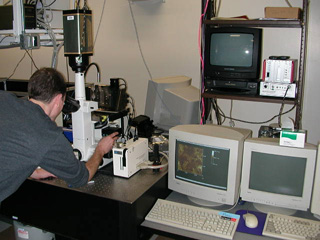Nanotechnology: Making Science a Smaller World
 |
|
|
Ryan Bailey at work
Photograph courtesy of Bailey
|
|
|
|
|
|
|
Ph.D. graduate student Ryan Bailey investigates the science of nanotechnology, which involves developing synthetic and analytical tools for characterizing and manipulating molecules and materials on a nanometer-length scale. On this scale, one billionth of one meter, materials exhibit remarkable properties that are different from those of macroscopic (large enough to be visible by the human eye) dimensions. Nanotechnology looks to exploit these fascinating properties in the development of improved technologies for areas such as electronics, public health, and environmental monitoring. Devices such as smaller and faster computers; microchips embedded in postage stamps to keep track of letters; selective drug delivery with nanotubules; and microchemical and biological sensors may contribute to more efficient, effective, and secure ways of life.
Size, shape, and composition are three of the most important factors in nanotechnology. An example of this is the size-dependent optical properties displayed by metallic “nanoparticles." Gold spheres of 100 nm reflect orange light, while gold spheres of 50 nm reflect green light. Shape is also crucial because differently shaped particles appear to have different colors. Silver spheres of 100 nm reflect yellow light, while silver triangles of similar size reflect red light. Composition also matters, as particles containing both gold and silver display optical properties altogether different from either pure gold or pure silver particles. Controlling the size, shape, and composition of nanoparticles is a good example of the power of nanotechnology, creating colors that span the entire visible spectrum with only simple materials.
Artists and chemists have been working at the nanometer scale for centuries. Much of the yellow- and red-colored stained glass on the rose window of the north façade of Notre Dame Cathedral, located in Paris and built during the Gothic period, is made up of nanometer-size particles of silver and gold. In this window, the particles of silver appear yellow because the small surfaces absorb violet wavelengths and reflect complementary yellow light. The gold particles appear red, likewise, because the small surface absorbs green light and reflects the complementary red.
One other large focus in the field of nanotechnology is the development of fast, sensitive, and small chemical and biological sensors. All the complicated functions of the human body can be broken down to the nanometer scale: from cells to proteins to DNA, our bodies are huge factories run by nanometer-sized parts. Bacteria, viruses, carcinogenic chemicals, and biological weaponry all attack the nanomachinery of the body, making their detection essential. Nanotechnology aims to develop techniques capable of quickly and accurately monitoring, containing, and remediating contaminated environments to ensure human health and public safety.
In 2000, the one-of-a-kind Northwestern University Institute for Nanotechnology was established with affiliated centers for nanofabrication and molecular self-assembly, transportations nanotechnology, and nanoscale science and engineering. While the primary goal of the institute is the development of this emerging scientific frontier, outreach programs highlighting the benefits of nanotechnology are offered for high-school students and teachers. For more information, visit the Institute for Nanotechnology Web site: http://www.nanotechnology.northwestern.edu/.